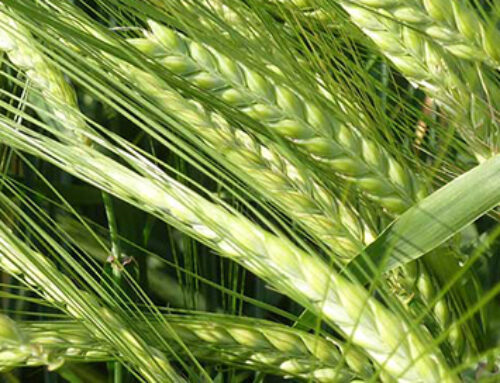Root Shoot Malting, Mainstem Malt and Carolina Malt House take home a coveted Malt Cup with pale malts seeded by LCS craft barley
The Craft Maltsters Guild presented its inaugural Malt Cup awards last month to three malt houses that exemplify the highest standards of quality and craftsmanship in malting. In a field of 21 international competitors, Root Shoot Malting of Loveland, Colorado, was awarded top honors. Mainstem Malt of Walla Walla, Washington, and Carolina Malt House of Cleveland, North Carolina, took home second and third place, respectively.
“The Malt Cup highlights the importance of creating a product that is not only high quality but also high in flavor,” says Jen Blair, Executive Director of the North American Craft Maltsters Guild. To select the Malt Cup winners, the Guild enlisted Montana State University’s Barley Breeding Program to conduct a malt quality analysis on each submission and prepare samples for blind sensory testing. Malts were then assessed for appearance, aroma, flavor and mouthfeel by a panel of craft malt industry experts.
The winning malt houses each had a unique take on their pale malt entries — the selected category for this year’s competition — but they all started with Limagrain Cereal Seeds (LCS) craft barley grown by local farmers. Root Shoot, Mainstem and Carolina Malt House are all part of the Acres to Ales program, a local craft beer supply chain that originates with LCS barley varieties.
Root Shoot Malting: Rooted in farming and the community
Root Shoot Malting decided to go with a winner when selecting its Malt Cup entry: Genie Pale, the Northern Colorado malt house’s most popular offering. Genie Pale malt has a honey flavor, creamy texture and bright color. It performs well during conversion and lautering, has low beta glucan and boasts a clean finish that allows brewers to accentuate hop flavors.
“Brewers have always loved Genie Pale malt’s flavor profile and performance,” says Emily Olander, Communications Director of Root Shoot Malting. Competition judges were equally smitten, awarding Root Shoot first place.
The backbone of Genie Pale malt is 2-row craft malting barley LCS Genie. As fifth generation farmers as well as maltsters, the owners of Root Shoot Malting are very selective about which barley varieties they choose for their malts. LCS Genie made the grade because of its excellent growing characteristics and the fact that it was bred for all-malt brewing. “The genetics are in line with what craft brewers are looking for,” explains Olander. “A more European-style variety, low beta glucan and lower protein, giving brewers more control over their mash.”
Mainstem Malt: Malt that matters
LCS Genie was the craft barley of choice for Mainstem’s Malt Cup entry as well. LCS Genie is the go-to variety for the Washington malt house, performing exceptionally well during the malting process and resulting in a rich flavor in the finished malt. But this crop was particularly remarkable.
“2018 Walla Walla Genie Pale malt was made with grain from a special place in the Walla Walla Valley foothills, grown with love by H.T. Rea Farms,” says Phil Neumann, Founder and CEO of Mainstem Malt. “In a malt industry built on blending, each of Mainstem’s malts are traceable back to a single farmer, field and vintage. We call this madness ‘Grain like Grapes,’ and believe it’s the key to unlocking new discoveries in malt flavor.”
Mainstem Malt is proud to be the hub of traceable supply chains that support family farms, rural communities and sustainability. Because every lot of grain is unique, so too is each premium malt. 2018 Walla Walla Genie Pale’s Malt Cup second place win reflects the care and quality that goes into each batch of Mainstem malt.
Carolina Malt House: Uniquely Carolina, world-class taste
Carolina pride is at the core of Carolina Malt House. “When we decided to build a malt house dedicated to Carolina-grown malt barley, we ran into a lot of people who told us the Carolinas couldn’t produce quality barley,” says Aaron Goss, Cofounder of Carolina Malt House. “[The Malt Cup third place award] proves that with a good barley variety well-adapted to this area, we can produce malt as good as anywhere in the world.”
Carolina Malt House barleys are subjected to a battery of tests before being accepted. “Starting with the best raw materials is vital,” states Goss. “We select from barleys that are capable of producing the technicals that our customers want to see through the malting process, and then select for the best beer flavor.” LCS Violetta is the malt house’s favorite two-row variety and the craft barley behind its winning pale malt, Carolina Gold.
Attention to detail is the key to Carolina Malt House’s success from start to finish. Carolina Gold, and all the Carolina malts, are created using a 22-ton pneumatic malting machine that Carolina Malt House designed and built in-house. In addition to having good control over the environment inside the machinery, maltsters collect around 15 million data points on each batch to help ensure quality and consistency.
The future of malt
As more craft brewers recognize the importance of flavorful, quality base malts, the demand for locally sourced and produced craft malt is on the rise. “We are constantly advocating for craft malt because we believe it will create better beers,” enthuses Root Shoot’s Olander. “It helps brewers identify with the local consumer and produce more complex, flavorful beers.”
“We find that brewers in our area readily recognize the value in their locally brewed beer also being locally grown,” echoes Carolina Malt House’s Goss. “The Malt Cup is important to show that [craft malt] is not just a gimmick or a fad — our industry makes beer this way because it’s a better product.”
The Craft Maltsters Guild hopes the Malt Cup awards will continue to grow the market for independently owned maltsters. “It gives our members an identifiable quality mark to use when marketing their malt,” says the Guild’s Blair. “The response has been overwhelmingly positive and the excitement continues to build.”
“The Malt Cup is, without a doubt, going to raise the bar for malt quality,” adds Mainstem’s Neumann.








